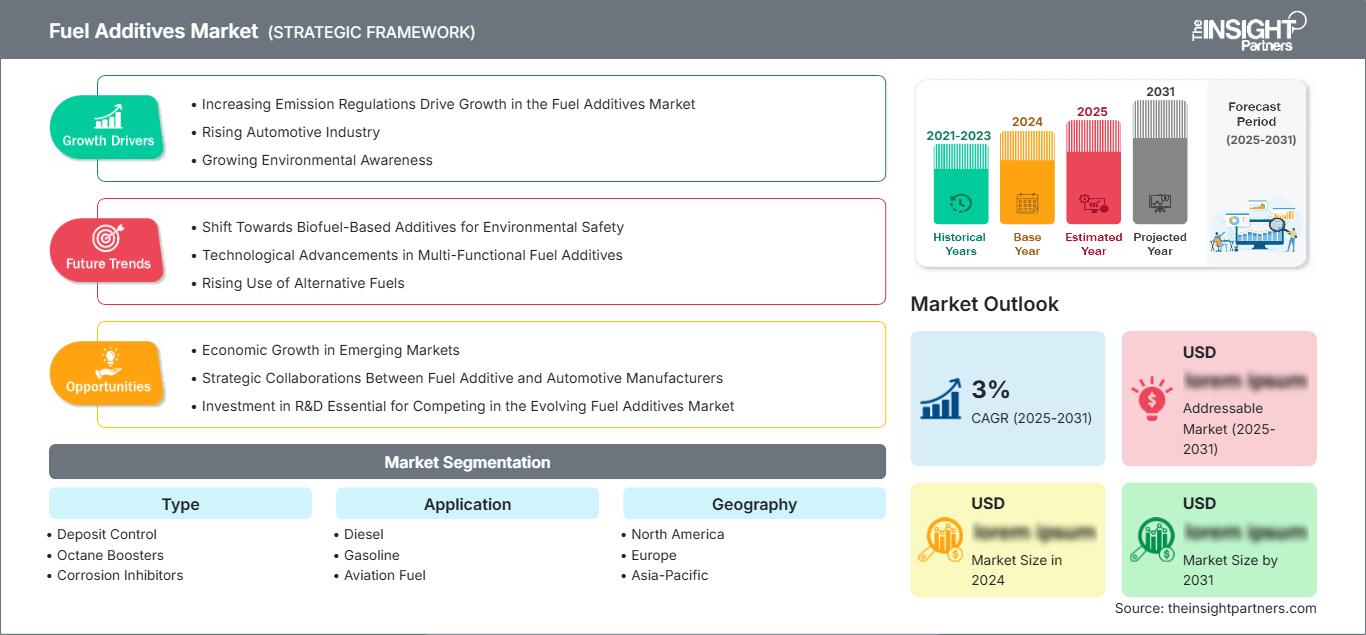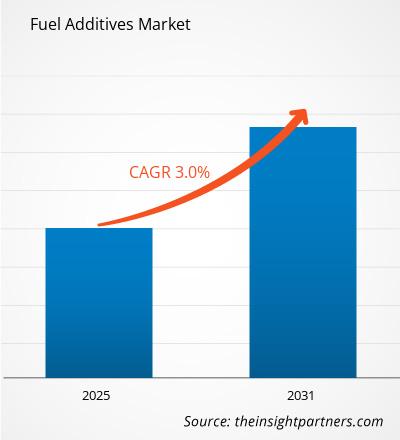Si prevede che il mercato degli additivi per carburante registrerà un CAGR del 3% dal 2025 al 2031, con una dimensione del mercato in espansione da XX milioni di dollari nel 2024 a XX milioni di dollari entro il 2031.
Il rapporto sul mercato degli additivi per carburante è segmentato per tipologia (controllo dei depositi, booster di ottano, inibitori di corrosione, agenti antidetonanti, antiossidanti, stabilizzanti, additivi lubrificanti, miglioratori del cetano e altri). Il mercato è segmentato in base all'applicazione (diesel, benzina, carburante per aviazione e altri). L'analisi globale è ulteriormente suddivisa a livello regionale e per i principali paesi. Le dimensioni e le previsioni del mercato a livello globale, regionale e nazionale per tutti i principali segmenti di mercato sono trattate nell'ambito di applicazione. Il rapporto fornisce il valore in USD per l'analisi, i segmenti, le regioni e i paesi sopra indicati. Il rapporto copre le tendenze del mercato, nonché le dinamiche di mercato come fattori trainanti, vincoli e opportunità chiave. Il rapporto include anche un'analisi del panorama industriale e della concorrenza, che include la concentrazione del mercato, l'analisi delle mappe di calore, i principali attori e i recenti sviluppi del mercato.
Scopo del rapporto
Il rapporto "Mercato degli additivi per carburante" di The Insight Partners mira a descrivere il panorama attuale e la crescita futura, i principali fattori trainanti, le sfide e le opportunità. Ciò fornirà spunti di riflessione a vari stakeholder aziendali, tra cui:
- Fornitori/produttori di tecnologia: per comprendere le dinamiche di mercato in evoluzione e conoscere le potenziali opportunità di crescita, consentendo loro di prendere decisioni strategiche informate.
- Investitori: per condurre un'analisi completa delle tendenze in merito al tasso di crescita del mercato, alle proiezioni finanziarie di mercato e alle opportunità presenti lungo la catena del valore.
- Enti di regolamentazione: per regolamentare le politiche e le attività di controllo sul mercato con l'obiettivo di ridurre al minimo gli abusi, preservare la fiducia degli investitori e sostenere l'integrità e la stabilità del mercato.
Tipo di segmentazione del mercato degli additivi per carburante
- Controllo dei depositi
- Booster di ottano
- Inibitori di corrosione
- Agenti antidetonanti
- Antiossidanti
- Stabilizzanti
- Additivi lubrificanti
- Miglioratori di cetano
Applicazione
- Diesel
- Benzina
- Carburante per aviazione
Potrai personalizzare gratuitamente qualsiasi rapporto, comprese parti di questo rapporto, o analisi a livello di paese, pacchetto dati Excel, oltre a usufruire di grandi offerte e sconti per start-up e università
Mercato degli additivi per carburanti: Approfondimenti strategici

-
Ottieni le principali tendenze chiave del mercato di questo rapporto.Questo campione GRATUITO includerà l'analisi dei dati, che vanno dalle tendenze di mercato alle stime e alle previsioni.
Fattori della crescita del mercato degli additivi per carburante
- L'aumento delle normative sulle emissioni stimola la crescita del mercato degli additivi per carburante: le crescenti restrizioni sul risparmio di carburante e sulle emissioni rappresentano uno dei principali fattori che influenzano il mercato degli additivi per carburante. Oggigiorno, i governi di tutto il mondo stanno introducendo sistemi civili per ridurre le emissioni di gas serra e migliorare la qualità dell'ecosistema. Anche l'inquinamento acustico ha favorito lo sviluppo di additivi per carburante, che contribuiscono a migliorare la produttività del motore, a migliorare l'efficienza della combustione e a ridurre le emissioni tossiche, rendendo le auto più ecologiche.
- Espansione del settore automobilistico: la crescita complessiva del settore automobilistico si sta verificando in tutte le parti del mondo, in particolare nei paesi in via di sviluppo. Dove c'è un elevato numero di veicoli di proprietà, c'è una corrispondente domanda di carburanti ad alte prestazioni. Gli additivi per carburante sono importanti per migliorare la qualità del carburante utilizzato, per mantenere il funzionamento efficiente del motore e per proteggerlo dall'usura eccessiva. Le tendenze esistenti sono rafforzate dalla crescente domanda di auto sportive e di fascia alta, che spesso richiedono additivi avanzati per migliorare l'efficienza dei motori.
- Crescente consapevolezza ambientale: la consapevolezza dell'importanza dell'ambiente e dello sviluppo sostenibile sta crescendo tra le persone, spingendo sia i consumatori che le industrie a modificare le proprie preferenze per i carburanti utilizzati, preferendo quelli più puliti. Gli additivi che contribuiscono a ridurre l'accumulo di carbonio, migliorare la conservazione del carburante e ridurre le emissioni sono sempre più richiesti. Lo stesso vale per altri settori, come l'aviazione e la nautica, dove le autorità di regolamentazione stanno spingendo verso l'utilizzo di carburanti più puliti e l'esecuzione di operazioni in modo efficiente.
Tendenze future del mercato degli additivi per carburanti
- Spostamento verso additivi a base di biocarburanti per la sicurezza ambientale: è attualmente in corso un processo di miglioramento e implementazione degli additivi a base di biocarburanti. L'attenzione alla sicurezza ambientale ha spostato l'attenzione dei produttori dagli additivi che migliorano semplicemente le prestazioni a quelli che migliorano anche le prestazioni del carburante, integrando al contempo prodotti con standard ecologici. Questi biocarburanti modificano i consumi durante il processo di combustione, contribuendo così a ridurre la quantità di combustibili fossili utilizzati.
- Progressi tecnologici negli additivi multifunzionali per carburanti: il mercato degli additivi per carburanti sta vivendo rapidi cambiamenti tecnologici. Uno dei cambiamenti più degni di nota è l'introduzione di additivi multifunzionali in grado di risolvere più di un problema alla volta. I progressi nella nanotecnologia, così come in alcuni aspetti dell'ingegneria chimica, stanno dando vita allo sviluppo di additivi per carburanti più potenti e affidabili. Nella maggior parte dei casi, questi miglioramenti migliorano l'efficienza della combustione, aumentano la stabilità del carburante e conferiscono al carburante proprietà antiusura e anticorrosione.
- Crescente utilizzo di carburanti alternativi: l'utilizzo di carburanti alternativi come biodiesel, etanolo e gas naturale compresso (CNG), tra gli altri, sta influenzando anche il mercato degli additivi per carburanti. Con l'aumento dell'uso di queste emissioni in diversi settori, è necessaria la disponibilità di additivi specifici per incrementarne l'impiego con gli attuali motori. Questa tendenza è tipica del cambiamento generale che mira a fornire fonti energetiche più pulite ed efficienti per le attività di rifornimento nel settore dei trasporti e in molti altri settori.
Opportunità di mercato per gli additivi per carburanti
- Crescita economica nei mercati emergenti: il rapido sviluppo economico registrato nella maggior parte dei mercati emergenti, in particolare nelle regioni Asia-Pacifico e America Latina, si è aperto, offrendo una buona finestra per l'espansione del mercato degli additivi per carburanti. Mentre queste regioni stanno sviluppando le loro infrastrutture e i loro sistemi di trasporto, con questo processo è destinata ad aumentare la necessità di carburanti e additivi di migliore qualità. Le aziende possono sfruttare questa espansione realizzando i propri prodotti con un'attenzione specifica alle regioni che soddisfano le specifiche normative, denominate requisiti, e a quelle dei consumatori.
- Collaborazioni strategiche tra produttori di additivi per carburante e produttori di automobili: le strategie congiunte dei produttori di additivi per carburante con le case automobilistiche consentono di ampliare la gamma dei prodotti sviluppati e migliorarne l'efficacia. Tale collaborazione si traduce spesso in un progresso nelle formulazioni degli additivi e nella crescita tecnologica, che contribuiscono a fornire prodotti adeguati alle mutevoli esigenze dei consumatori e degli enti regolatori. Questa strategia di marketing sarebbe utile anche per promuovere e vendere additivi per carburante in altri segmenti di mercato.
- Investimenti in ricerca e sviluppo essenziali per competere nel mercato in evoluzione degli additivi per carburante: gli investimenti in ricerca e sviluppo sono, in un certo senso, una necessità per sopravvivere e persino competere nel mercato degli additivi per carburante. Una manciata di aziende che probabilmente domineranno gli altri concorrenti in questo segmento sono quelle che intraprendono attività di ricerca e sviluppo per sviluppare additivi dalle prestazioni avanzate. Utilizzando materiali, formulazioni e tecnologie appropriate, è possibile il progresso di prodotti che mirano a soddisfare la domanda di carburante e la sostenibilità ambientale.
Approfondimenti regionali sul mercato degli additivi per carburante
Le tendenze regionali e i fattori che influenzano il mercato degli additivi per carburanti durante il periodo di previsione sono stati ampiamente spiegati dagli analisti di The Insight Partners. Questa sezione illustra anche i segmenti e la distribuzione geografica del mercato degli additivi per carburanti in Nord America, Europa, Asia-Pacifico, Medio Oriente e Africa, America Meridionale e Centrale.
Ambito del rapporto di mercato sugli additivi per carburante
| Attributo del rapporto | Dettagli |
|---|---|
| Dimensioni del mercato in 2024 | US$ XX million |
| Dimensioni del mercato per 2031 | US$ XX Million |
| CAGR globale (2025 - 2031) | 3% |
| Dati storici | 2021-2023 |
| Periodo di previsione | 2025-2031 |
| Segmenti coperti |
By Tipo
|
| Regioni e paesi coperti |
Nord America
|
| Leader di mercato e profili aziendali chiave |
|
Densità degli operatori del mercato degli additivi per carburanti: comprendere il suo impatto sulle dinamiche aziendali
Il mercato degli additivi per carburanti è in rapida crescita, trainato dalla crescente domanda degli utenti finali, dovuta a fattori quali l'evoluzione delle preferenze dei consumatori, i progressi tecnologici e una maggiore consapevolezza dei benefici del prodotto. Con l'aumento della domanda, le aziende stanno ampliando la propria offerta, innovando per soddisfare le esigenze dei consumatori e sfruttando le tendenze emergenti, alimentando ulteriormente la crescita del mercato.

- Ottieni il Mercato degli additivi per carburanti Panoramica dei principali attori chiave
Punti di forza
- Copertura completa: il rapporto analizza in modo esaustivo prodotti, servizi, tipologie e utenti finali del mercato degli additivi per carburante, offrendo una panoramica olistica.
- Analisi degli esperti: il rapporto è redatto sulla base della conoscenza approfondita di esperti e analisti del settore.
- Informazioni aggiornate: il rapporto garantisce la pertinenza aziendale grazie alla copertura di informazioni e dati recenti.
- Opzioni di personalizzazione: questo rapporto può essere personalizzato per soddisfare le esigenze specifiche del cliente e adattarsi in modo appropriato alle strategie aziendali.
Il rapporto di ricerca sul mercato degli additivi per carburante può quindi contribuire a guidare il percorso di decodificazione e comprensione dello scenario del settore e delle prospettive di crescita. Sebbene possano esserci alcune preoccupazioni valide, i vantaggi complessivi di questo rapporto tendono a superare gli svantaggi.
- Analisi storica (2 anni), anno base, previsione (7 anni) con CAGR
- Analisi PEST e SWOT
- Valore/volume delle dimensioni del mercato - Globale, Regionale, Nazionale
- Industria e panorama competitivo
- Set di dati Excel
Report recenti
Rapporti correlati
Testimonianze
Motivo dell'acquisto
- Processo decisionale informato
- Comprensione delle dinamiche di mercato
- Analisi competitiva
- Analisi dei clienti
- Previsioni di mercato
- Mitigazione del rischio
- Pianificazione strategica
- Giustificazione degli investimenti
- Identificazione dei mercati emergenti
- Miglioramento delle strategie di marketing
- Aumento dell'efficienza operativa
- Allineamento alle tendenze normative






















 Ottieni un campione gratuito per - Mercato degli additivi per carburanti
Ottieni un campione gratuito per - Mercato degli additivi per carburanti